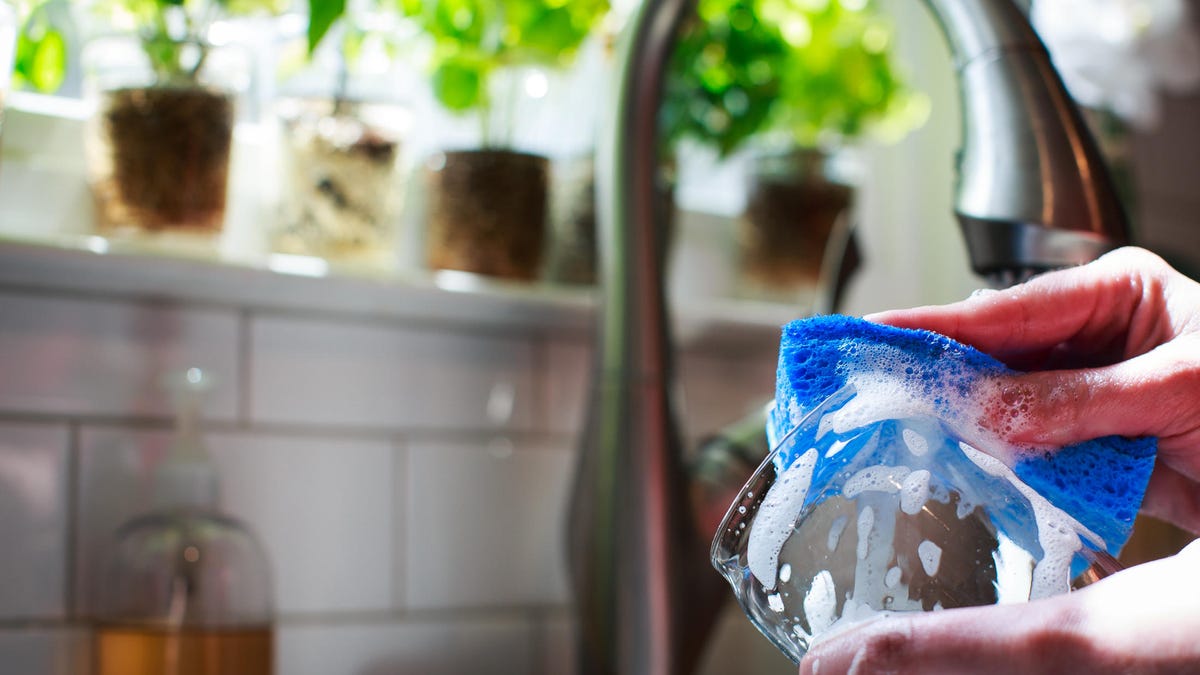 Why You Can Trust CNET
Why You Can Trust CNET How to choose the right sponge (and make washing dishes less painful)
Learn which sponges tackle what cleaning chores the best.

Most of us don't give much thought to sponges. But if you hate doing the dishes (who doesn't), a good sponge will make the task a little less painful. Better yet, using the right sponge can save time and prevent damage to your kitchenware.
Here's a guide to every sponge type and how to choose the right sponge for your needs.
Common sponge types
Take a look at this list of sponge types you've likely encountered. Most are synthetic, though some are derived from plant cellulose. There are natural sponges, too, which have been used as cleaning tools for millennia.
Cellulose
These sponges are made from recycled plant fibers. Sources include wood pulp and cotton. They're inexpensive and very absorbent.
Heavy-duty
Sponges marked as heavy-duty are highly abrasive. Use them to remove tough, stuck-on debris from stainless-steel pots and baking pans. Don't use them for nonstick cookware.
Natural
The sponge is a simple aquatic animal, to which all artificial sponges owe their name. Their porous, fibrous skeletons are soft and absorb lots of liquid. Throughout history sea sponges have been harvested for these properties.
Nonscratch
Sponges with this label are safe to use on nonstick pots and pans. They also won't scratch the surfaces of ceramic bakeware.
A sponge can clean many different surfaces around the home.
Other cleaning tools
Plastic scrubbers
These round or rectangular cleaning tools are made of woven plastic fibers. They're typically nonscratch, and are safe to use on nonstick and ceramic cookware.
Scouring pads
Much thinner than a sponge, these flat squares of fabric come in both nonscratch and heavy-duty varieties. Use them to rub away tough stains and grime from countertops, cookware and bakeware and in the bathroom.
Steel wool
The big guns of home cleaning, steel wool pads are abrasive in the extreme. Use them only on surfaces that can take their abuse, such as stainless-steel pots, pans, and baking sheets.
The right sponge for the job
Plates and dishes
You have a lot of options for hand-washing dirty dishes. If they're fragile or awkwardly shaped, use a handled sponge tool. Otherwise, go with cellulose sponges.
These type of sponges are relatively inexpensive and absorb liquid and soap easily. They're also prone to collecting bits of food over time. That means bacteria, not to mention funky odors, can develop inside them.
To combat this, make sure to sanitize your sponge weekly and toss it out when it shows signs of wear.
When washing glassware, using a regular-shaped sponge can be awkward.
Pots and pans
Stainless-steel saucepans, baking sheets and other hardy kitchenware attract lots of grime. To get rid of that buildup, use a sponge that's just as tough.
Abrasive sponges are typically rough on one of their sides. Use that surface to power through caked-on grit and clingy food debris. They come in both synthetic and cellulose varieties.
Don't scrub your nonstick pots and pans with an abrasive sponge. You'll likely scratch and damage their Teflon coating. Your best bet is to use a nonabrasive sponge such as the O-Cedar Scrunge. And a little elbow grease.
That same is true for ceramic cookware. Abrasive sponges will scratch and mar the enamel. Soak these pans in water first, then wash with a soft cellulose or synthetic sponge. Harsh abrasives will harm copper pots and pans too.
For stubborn copper stains, pretreat pans with salt plus lemon juice (or vinegar). Then rub with a cloth rag or nonabrasive sponge.
Glassware
To clean fragile glassware such as stemware and even water glasses, an abrasive sponge is overkill. Chose something soft and not likely to scratch, like a microfiber or nonabrasive cellulose sponge.
The shape of a glassware sponge is important too. For long, narrow glasses, sponges with thin heads and long handles work best.
Windows and cars
Detail your car like a pro. Grab a microfiber or a natural sponge that's nonabrasive, and absorbs plenty of water and soap.
They won't mar automobile paint, window glass, or metal. Plus they're great at wicking away oils and grease, to leave behind a squeaky-clean shine.

